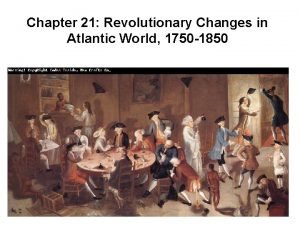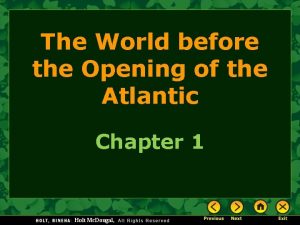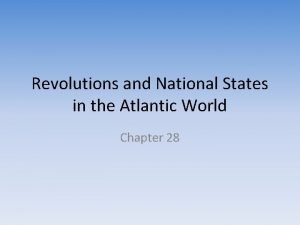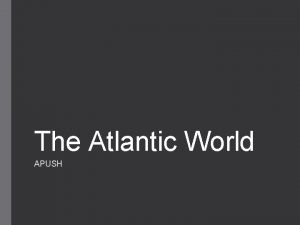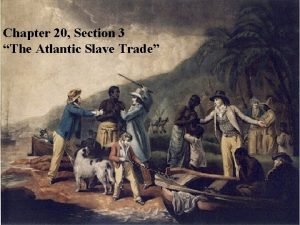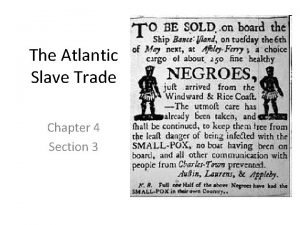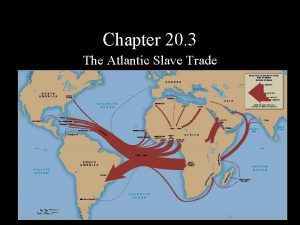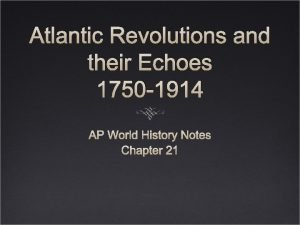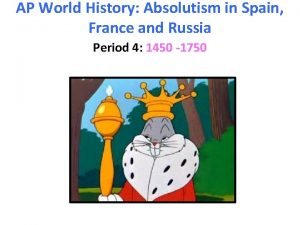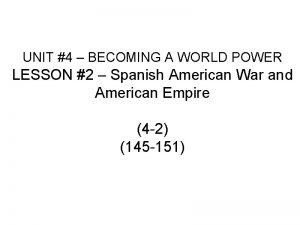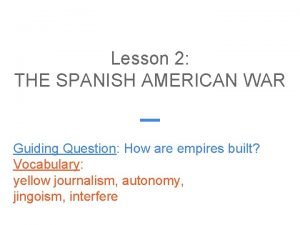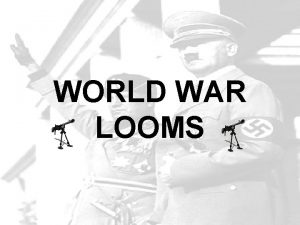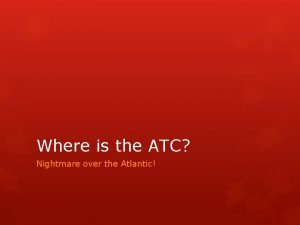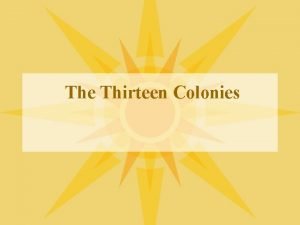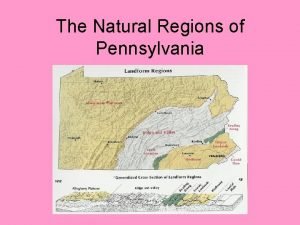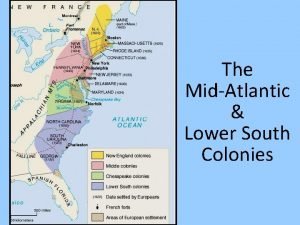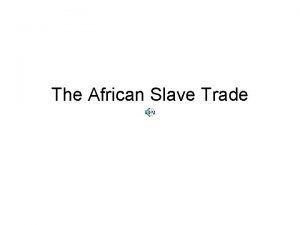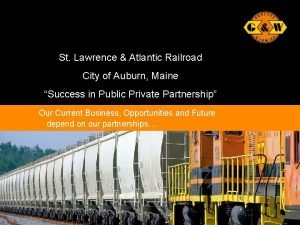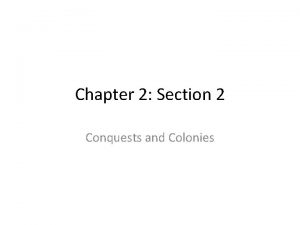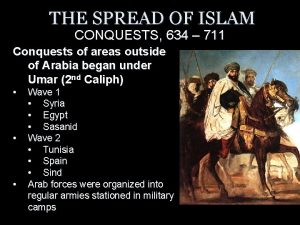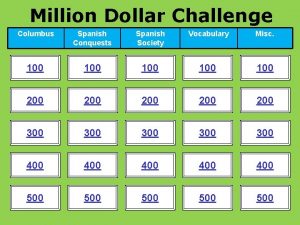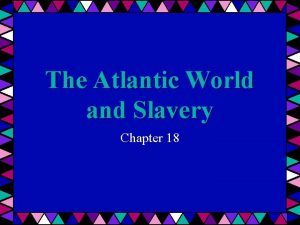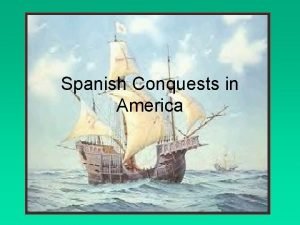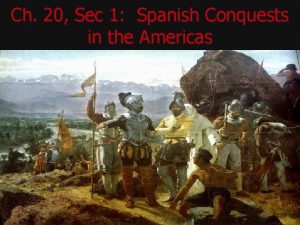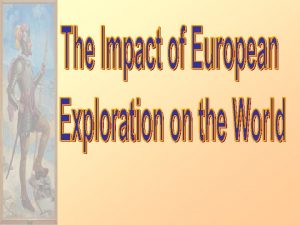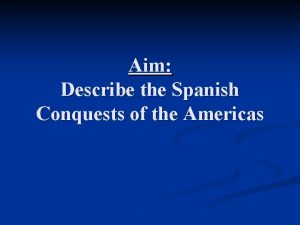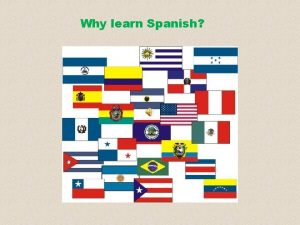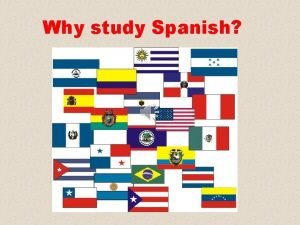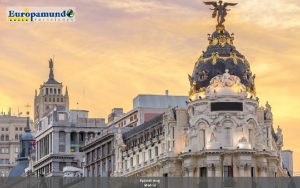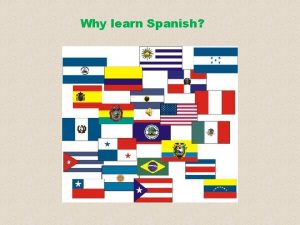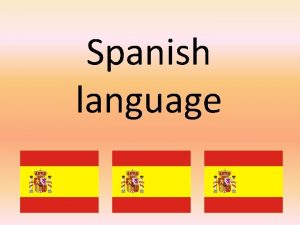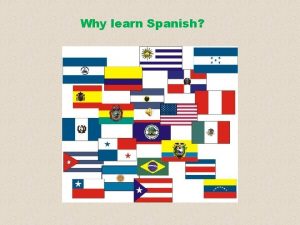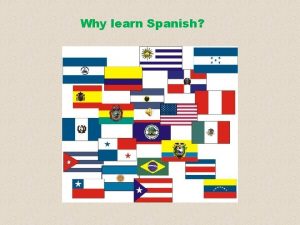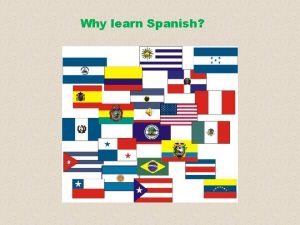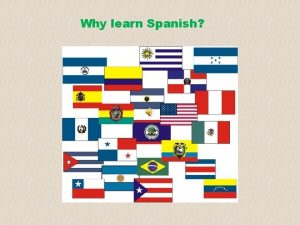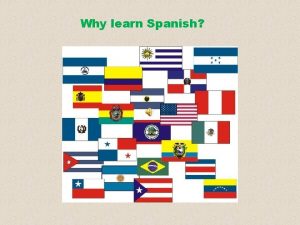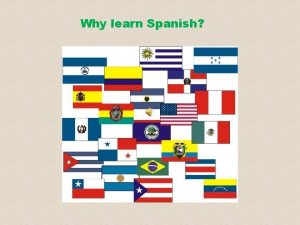The Atlantic World Chapter 4 Spanish Conquests in

































































- Slides: 65

The Atlantic World Chapter 4

Spanish Conquests in the Americas Chapter 4 Section 1

Paving the Way – Christopher Columbus made voyage for Spain in 1492 – Looked for an alternate trade route to Asia, instead landed in the Caribbean instead. – Thought he landed in the East Indies – Called the people “Indians”, in reality the people called themselves “Taino” – Called the island San Salvador

Goal of Columbus – Columbus wanted to find gold – After not finding any on Salvador, he explored other islands – After returning to Spain, he got approval for even more voyages

Other Voyages of Columbus – Brought a larger group with him – 17 ships, many armed soldiers, and 1, 000 settlers – Wanted to turn the Caribbean islands into colonies – Lands controlled by another nation

Other Explorers – Amerigo Vespucci – Italian sailing for Portugal – Determined that South America was not part of Asia (Also, America is named after him – Ferdinand Magellan – Sailed around the tip of South America, circumnavigated the world – Magellan died in the Philippines, but he crew continued

Classwork – Complete the following (Due tomorrow) – A on page 103 – B on page 105 – Geography Skillbuilder on page 104

Empire Building

Hernando Cortes – Sailed to the American mainland (in Mexico) – Looked to claim lands for Spain – One of the conquistadors – Spanish who looked to claim land in the Americas

Cortes, Cont’d – Learned of the wealthy Aztec Empire, marched weeks to get to the empire – Reached the capital of Tenochtitlan – The emperor had mistaken Cortes for a god that was said to return about the same time – Gave Cortes a large share of the gold supply, but Cortes wanted more

Cortes, Cont’d – Cortes forced the Aztecs to mind for gold and silver more, eventually the Aztecs rebelled – Cortes was able to defeat the Aztecs with a much smaller force

Reasons Cortes Defeated the Aztecs – Superior Weaponry – Arrows vs Muskets – Cortes had help from rival groups of Natives – Diseases – Measles, mumps, smallpox

Francisco Pizarro – Conquered the Inca Empire in Peru – Arranged a meeting with Atahualpa, the Inca ruler in an outlying city of Cajamarca – The Spanish unexpectedly attacked the Incas, and kidnapped Atahualpa

Kidnapping, Cont’d – The Incas promised a room filled once with gold and twice with silver for the release of the king – However, once the Spanish got the ransom, they killed Atahualpa anyways – This demoralized the Incas, the Pizarro was able to capture the capital of Cuzco without a struggle

Actions Throughout the Empire – The Spanish would live alongside the natives and teach them Spanish culture – Most Spanish to come to the Americas were men, so they would marry native women – Created a large mixed Spanish and Native American population – Mestizo

Brazil – Cabral claimed Brazil for Portugal – The Portuguese began cultivating the area for sugar after realizing there was little gold or silver

Spain Expands Even More – The American expeditions made Spain very wealthy – To protect ships carrying riches back to Spain, they built up a powerful navy – Also built up army

Other Conquistadors – Juan Ponce de Leon- Florida – According to legend, he was searching for the Fountain of Youth – Vasquez de Coronado- Arizona, New Mexico, Texas, Oklahoma, Kansas

Opposition to the Spanish Rule – Priests would come to the Americas with the Spanish to spread Christianity – Priests spoke out against the treatment of the Natives under Spanish Rule – Natives also would resist Spanish rule periodically.

Homework Option 1 Option 2 – 2 Graphic organizers – Write a journal detailing the capture of the Aztec Empire – Detailing the Conquistadors and where they conquered – Why Cortes was successful

Competing Claims for North America Chapter 4 Section 2

More Countries Explore – Many traders looked for an all-water route to Asia. – Magellan’s journey proved that it was possible to travel West from Europe to Asia – Looked to find a faster way around or through America – After not finding an all-water route, countries decided to settle the land

Important People in the Establishment of New France – Giovanni da Verrazano- Discovered New York Harbor – Jacques Cartier- discovered and named the St. Lawrence River, found island that would later become Montreal – Samuel de Champlain- traveled further up the St. Lawrence River, claiming the area of Quebec for France

Important People in the Establishment of New France, Cont’d – Jacques Marquette and Louis Joliet explored Great Lakes and upper Mississippi River – Sieur de La Salle- explored the lower Mississippi River, claimed the Mississippi River Valley for France, named it Louisiana after King Louis XIV

Characteristics of New France – France established a large area, but it was not heavily populated – Most French colonists didn’t want to establish towns or families – The French set up major fur trading networks in North America

Jamestown – British settlement by the Virginia Company – Named after King James – The Colony did not have a good start as 7 out of every 10 people died – When colonists first arrived, they didn’t concern themselves with building shelters or growing crops, they were more concerned with looking fro gold

Jamestown, Cont’d – The Colony of Jamestown recovered – Mostly due to the discovery of tobacco – Eventually, the colony had such little economic prosperity, it was turned back over to King James

New England – In 1620, a second English colony was founded in Plymouth, Massachusetts – The Pilgrims moved to America for religious freedom – Later the Puritans established another colony in Massachusetts Bay – Puritans wanted to build a model community to be an example to other Christians

The Dutch – The Dutch established the Dutch East India Company to compete in the trade of the Indian Ocean, later turned attention to the Americas – Henry Hudson, working for the Dutch looked for an allwater route to Asia (He didn’t find one) – He did, however, find the Hudson River, Hudson Strait, and Hudson Bay – The Dutch were heavily involved in fur trade

The Dutch, Cont’d – The Dutch called their colony New Netherland – It was home to a very diverse population

Homework Option 1 Option 2 – Construct a timeline of the colonization of North America – Create a map of the various colonies and claims of European countries in North America

The Fight for North America – France, England, and Netherlands battled for colonial supremacy – King Charles II of England gave his brother, the Duke of York, permission to drive out the Dutch – The Dutch surrendered without a fight

Fight for North America, Cont’d – English wanted more land, moved west and made contact in France’s holdings – In 1754, land disputes between British and French in the Ohio Valley led to war – French and Indian War – Part of the 7 years war – Britain won the war, gained more land control

Reaction of Native Americans – European colonization proved disastrous for Native Americans – Spread of disease and warfare – The French and Dutch had more cooperative relationships with the Natives

Native Relations with French and Dutch – French and Dutch settlers were heavily involved in fur trading – The natives would trap animals, then trade the furs to Europeans in exchange for guns, hatchets, mirrors, beads – Dutch eventually wanted more land, leading to disagreements between them and the natives

Native Relations with British – Many who came from Britain had poor views of Native Americans – Puritans considered the natives to be heathens (people without a faith) – Viewed natives as agents of the devil

Native Relations with British – Natives developed harsh view of white invaders – Native American ruler Metacom led an attack on 52 colonial villages throughout Massachusetts

Natives Fall to Disease – Devastated native populations – Smallpox epidemic in 1616

– Number 2 on Page 114

Atlantic Slave Trade

Evolution of African Slavery – Slavery existed all over the world, but it increased in Africa with the spread of Islam – Belief that non-Muslim prisoner of war could be bought and sold as slaves – From 650 to 1600 - 438 million Africans were transported to Southwest Asia to work mostly as domestic servants

Difference in Slavery in Africa and in Americas – Marriage into the family of owners could free the enslaved person – Slavery was not hereditary, if a slave had children, those children were free

Europeans Enter African Slave Trade – In the 1400’s, Portuguese were the first to visit Africa – First was looking for gold, but once the colonies in the Americas started prospering, they looked for ways to increase American labor force

Reasons Africans Were Picked – Africans had a better immunity to European diseases – Experience in farming – Less likely to try and escape because of no ties or familiarity with the land

The Atlantic Slave Trade – Buying and selling of Africans for work in the Americas – Quickly became massive enterprise – Over 9. 5 million Africans were sent to the Americas

Slave Trade, Cont’d – Spain in Portugal were leaders in early slave trade – Growing industry of sugar plantations led to an increased need of labor – Dutch, French, and English colonies in the Caribbean also used slaves for sugar, tobacco, and coffee plantations – From 1690 to 1807, England became the leading carrier of slaves

Role of Africans in the African Slave Trade – African rulers and merchants would capture and delivered slaves to Europeans – African rulers would look to wipe out enemy groups – In return, rulers and merchants would get gold, guns, amongst other goods

African Resistance to Slave Trade – Some rulers started to speak out against the slave trade – King Nzinga Mbemba of Congo

Triangular Trade

Triangular Trade – System of a trade network between – Europe – Africa – The Americas

Routes of Triangular Trade – Europeans transported manufactured goods to Africa – African slaves were sold to the West Indies – Sugar, coffee, and tobacco were transported to Europe

Routes, Cont’d – Rum and manufactured goods would be traded to Africa – Exchanged for African slaves – Slaves transported to the West Indies, sold for sugar and molasses – Sugar and molasses were sold to rum producers in New England

Middle Passage – The voyage that brought captured Africans to the West Indies (and later North and South America) – Called middle passage because it was the middle leg of the trade network

Conditions in the Middle Passage – Captured people were crammed into tight areas – Would be whipped or beaten by the merchants – Diseases were common on ships – Lived in their own vomit and human waste – Some committed suicide by jumping overboard – It’s estimated that 20% of Africans died on each ship

Classwork – If you haven’t already, Number 2 on page 119 – Section 4

The Columbian Exchange Chapter 4 Section 4

What is the Columbian Exchange? – A global transfer of foods, plants, and animals during the colonization of the Americas – Brought foods that Europeans, Asians, and Africans hadn’t seen before

Goods Transferred FROM the Americas – Corn and Potatoes probably the most important – Inexpensive to grow and very nutritious – Tomatoes, squash, cacao beans (for chocolate), turkey

Goods Transferred TO the Americas – Grapes – Horses, cattle, and pigs – Bananas – Wheat

Others that Transferred TO the Americas – Diseases led to the death of millions of Native Americans – Natives didn’t have immunity to diseases from other parts of the world – Smallpox – Influenza – Measles

A Commercial Revolution – Because of the increase trade and wealth from the Americas, a new way of doing business arose – Known as the Commercial Revolution

Capitalism – Economic system based on private ownership – Also includes investment of wealth for profit – (Before this, the government were the only ones with a lot of wealth) – Merchants were the first to gain wealth from oversea trade – Led to some inflation

Joint-Stock Companies – Similar to a corporation today – Large number of people pool their money together to invest – If company failed, then investors only lost a small sum – If company was successful, then investors would share profits

Mercantilism – Adopted by many countries – The belief that a country’s power is dependent on its wealth – Two ways a country can build wealth – Increase holdings of gold and silver – Sell more goods than bought

Homework – Which continent was impacted the most from the Columbian Exchange? Explain why you think that in a paragraph. (Explain your reaonsing)
 Ap world history chapter 25 africa and the atlantic world
Ap world history chapter 25 africa and the atlantic world Which egyptian ruler avoided military conquests
Which egyptian ruler avoided military conquests Chapter 21 revolutionary changes in the atlantic world
Chapter 21 revolutionary changes in the atlantic world The world before the opening of the atlantic
The world before the opening of the atlantic Revolutions and national states in the atlantic world
Revolutions and national states in the atlantic world Anglicization apush
Anglicization apush The atlantic slave trade chapter 20 section 3
The atlantic slave trade chapter 20 section 3 Atlantic revolutions global echoes
Atlantic revolutions global echoes Chapter 4 section 3 the atlantic slave trade
Chapter 4 section 3 the atlantic slave trade Chapter 20 section 3 the atlantic slave trade
Chapter 20 section 3 the atlantic slave trade Atlantic revolutions and their echoes
Atlantic revolutions and their echoes Spanish packet answers
Spanish packet answers Hát kết hợp bộ gõ cơ thể
Hát kết hợp bộ gõ cơ thể Slidetodoc
Slidetodoc Bổ thể
Bổ thể Tỉ lệ cơ thể trẻ em
Tỉ lệ cơ thể trẻ em Chó sói
Chó sói Chụp phim tư thế worms-breton
Chụp phim tư thế worms-breton Alleluia hat len nguoi oi
Alleluia hat len nguoi oi Môn thể thao bắt đầu bằng từ chạy
Môn thể thao bắt đầu bằng từ chạy Thế nào là hệ số cao nhất
Thế nào là hệ số cao nhất Các châu lục và đại dương trên thế giới
Các châu lục và đại dương trên thế giới Cong thức tính động năng
Cong thức tính động năng Trời xanh đây là của chúng ta thể thơ
Trời xanh đây là của chúng ta thể thơ Cách giải mật thư tọa độ
Cách giải mật thư tọa độ Làm thế nào để 102-1=99
Làm thế nào để 102-1=99 độ dài liên kết
độ dài liên kết Các châu lục và đại dương trên thế giới
Các châu lục và đại dương trên thế giới Thơ thất ngôn tứ tuyệt đường luật
Thơ thất ngôn tứ tuyệt đường luật Quá trình desamine hóa có thể tạo ra
Quá trình desamine hóa có thể tạo ra Một số thể thơ truyền thống
Một số thể thơ truyền thống Cái miệng nó xinh thế
Cái miệng nó xinh thế Vẽ hình chiếu vuông góc của vật thể sau
Vẽ hình chiếu vuông góc của vật thể sau Thế nào là sự mỏi cơ
Thế nào là sự mỏi cơ đặc điểm cơ thể của người tối cổ
đặc điểm cơ thể của người tối cổ Giọng cùng tên là
Giọng cùng tên là Vẽ hình chiếu đứng bằng cạnh của vật thể
Vẽ hình chiếu đứng bằng cạnh của vật thể Fecboak
Fecboak Thẻ vin
Thẻ vin đại từ thay thế
đại từ thay thế điện thế nghỉ
điện thế nghỉ Tư thế ngồi viết
Tư thế ngồi viết Diễn thế sinh thái là
Diễn thế sinh thái là Dạng đột biến một nhiễm là
Dạng đột biến một nhiễm là Bảng số nguyên tố
Bảng số nguyên tố Tư thế ngồi viết
Tư thế ngồi viết Lời thề hippocrates
Lời thề hippocrates Thiếu nhi thế giới liên hoan
Thiếu nhi thế giới liên hoan ưu thế lai là gì
ưu thế lai là gì Khi nào hổ mẹ dạy hổ con săn mồi
Khi nào hổ mẹ dạy hổ con săn mồi Sự nuôi và dạy con của hổ
Sự nuôi và dạy con của hổ Sơ đồ cơ thể người
Sơ đồ cơ thể người Từ ngữ thể hiện lòng nhân hậu
Từ ngữ thể hiện lòng nhân hậu Thế nào là mạng điện lắp đặt kiểu nổi
Thế nào là mạng điện lắp đặt kiểu nổi Latin america webquest answers
Latin america webquest answers Divine right of kings definition ap world history
Divine right of kings definition ap world history Becoming a world power lesson 2 the spanish american war
Becoming a world power lesson 2 the spanish american war Chapter 5 lesson 2 the spanish american war
Chapter 5 lesson 2 the spanish american war Atlantic charter summary
Atlantic charter summary Nightmare over the atlantic
Nightmare over the atlantic The mid atlantic colonies
The mid atlantic colonies Piedmont region pa
Piedmont region pa The mid atlantic colonies
The mid atlantic colonies Atlantic slave trade
Atlantic slave trade The atlantic ocean gets about 3-5 ______ wider each year.
The atlantic ocean gets about 3-5 ______ wider each year. St lawrence and atlantic railroad
St lawrence and atlantic railroad


